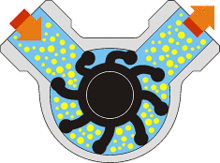Flexible impeller
From Wikipedia, the free encyclopedia

FLEXIBLE IMPELLER PUMPS - how it works -
The variation of vane volume during the rotation cause the excellent dry selfpriming feature of the pump.
Pump is also reversible.
The variation of vane volume during the rotation cause the excellent dry selfpriming feature of the pump.
Pump is also reversible.
Main article: Pump
A flexible impeller pump is a positive-displacement pump that, by deforming impeller vanes, draws the liquid into the pump housing and moves it to the discharge port with a constant flow rate. This principle combines gentle pumping with a high dry self-priming action.
Types
- Execution: close coupled, bare shaft, with hydraulic motor, belt driven, gearmotor, mechanical speed variator, frequency converter,...
- Fittings: DIN 11851, Garolla, BSP, Macon, Triclover, SMS, BSM/RJT,...
Uses
Particularly suitable for transfer of viscous, delicate, and slurry fluids even with high solid content. Widely used in the oenological field, food processing, chemical industry, cosmetic and marine field.
Materials
Pump housing can be made of high grade stainless steel, bronze for marine applications, or other materials.
The impeller can be made of:

Flexible Impeller
- Natural Rubber (NR) - Excellent for water based liquid, highest mechanical resistance.
- Neoprene (CR) - Good balance between chemical and mechanical resistance.
- Nitrile (NBR) - Excellent resistance to oils and fats.
- EPDM - Best for hot fluid, for acid and alkaline fluids.
- Silicon (VMQ) - Best for very high temperature.
The end face mechanical seal can be made of:
- Ceramic
- Stainless steel
- Graphite
- Tungsten carbide
- Silicon carbide
- Elastomers: NBR, EPDM, VITON,...
This article is issued from Wikipedia. The text is available under the Creative Commons Attribution/Share Alike; additional terms may apply for the media files.